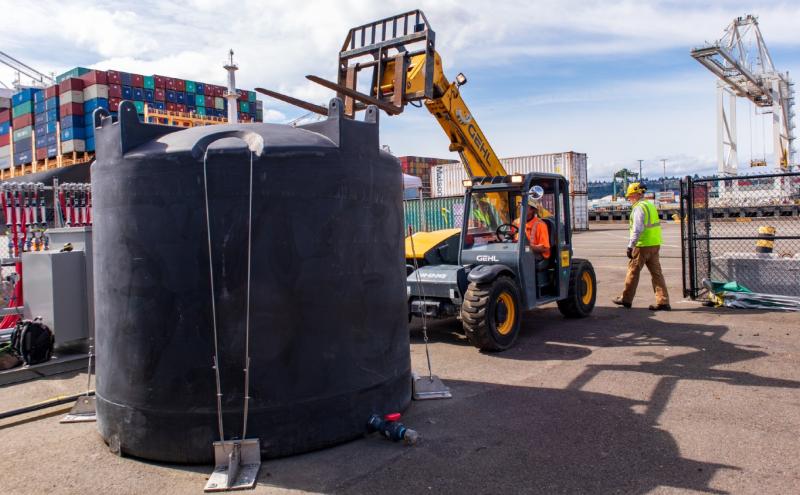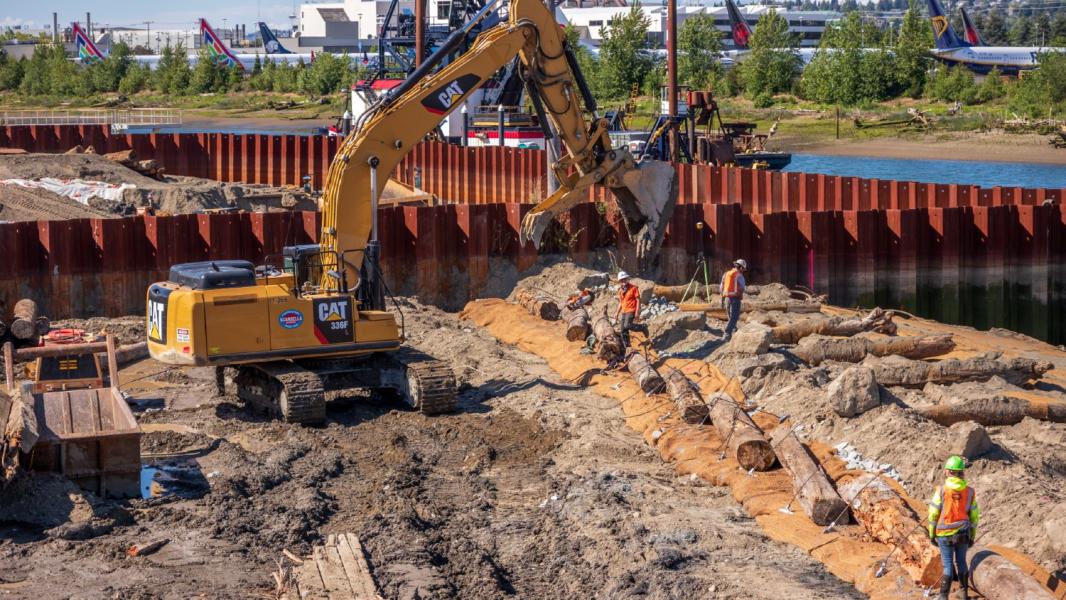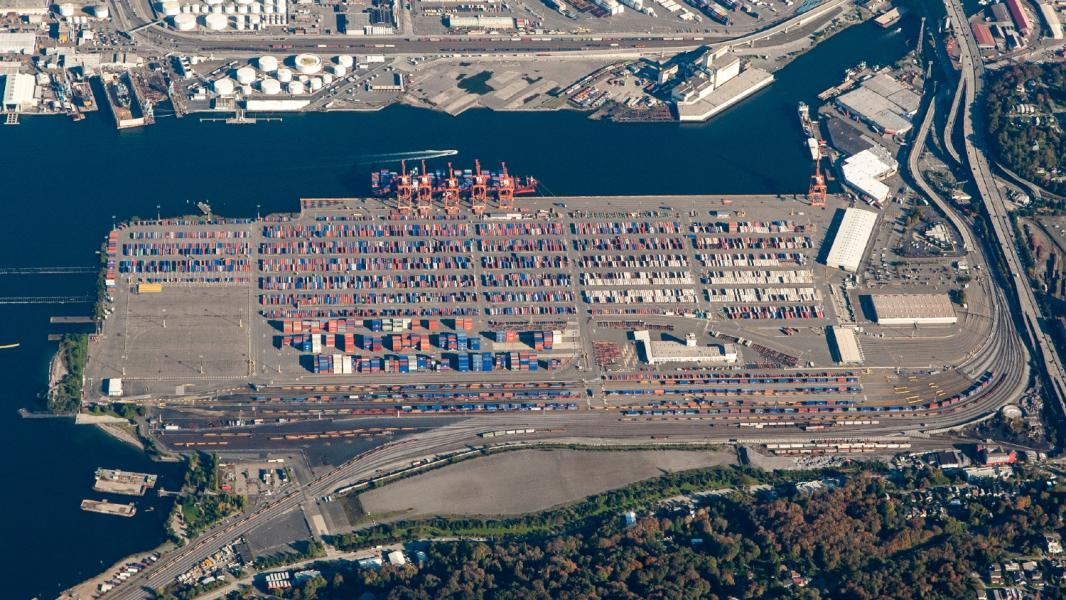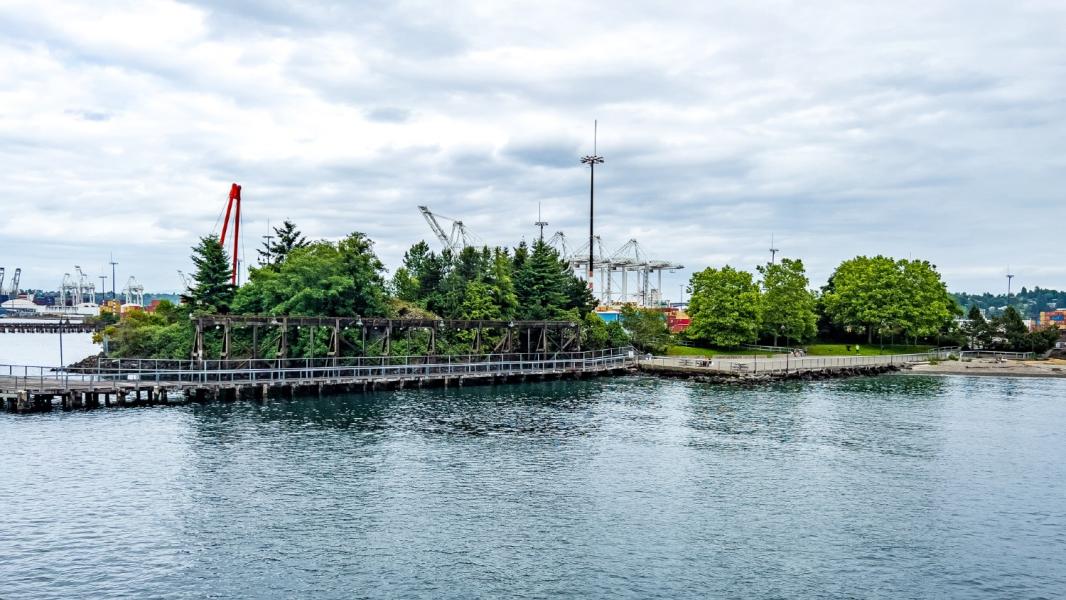
Learn more about the Port's completed cleanup projects below. Contact information for each project is provided.

Learn more about the Port's completed cleanup projects below. Contact information for each project is provided.
Terminal 117, formerly known as the Malarkey Asphalt Plant, located at 8700 Dallas Avenue South on the west side of the Duwamish River in South Park. The site is adjacent to the Boeing Company, the South Park Marina, and several South Park residences.
The site is currently a habitat restoration site and community park know as Duwamish River People’s Park.
Learn more about the cleanup project here.
Starting in 1937, the Duwamish Manufacturing Company and Malarkey Asphalt Company operated here with minimal environmental regulations, as the US Environmental Protection Agency (EPA) was not formed until 1970. These companies heavily polluted the soil and shoreline of the site and went out of business in 1993. The Port acquired a portion of the property in 1999 with the plan to build a maritime cargo terminal. In 2003, the EPA designated the site as a highly toxic “Early Action” Superfund site. The EPA found contaminated soil, asphalt, oil, pipelines, a non-leaking underground diesel storage tank, drums and debris in the riverbank resulting in risks of exposures to PCBs (polychlorinated biphenyls), highly toxic chemicals hazardous to public health than were banned in the 1970s. Since the Port and City now owned these polluted areas, both government agencies became responsible for cleaning up the contamination.

The primary contamination of concern was PCBs in soil, sediment, and groundwater.
Designated by the U.S. Environmental Protection Agency (EPA) as an Early Action Area as part of the Lower Duwamish Waterway Superfund site, Terminal 117 was cleaned up as a joint project of the Port of Seattle and the City of Seattle with oversight by the EPA. After the cleanup, the Port converted 14 acres to critical fish and wildlife habitat and public shoreline access. This large-scale restoration project supports recovery of the endangered Southern Resident orca population by significantly increasing habitat critical to abundance and health of Chinook salmon.
Terminal 117 uplands soil and in-water sediments cleanup was completed in December 2014. The uplands cleanup included removal of pavement, derelict structures and 60,000 tons of soil and sediment. PCB contaminated soil and sediments were excavated and hauled off-site to a licensed waste landfill. The City of Seattle began the next phase of environmental cleanup in 2015, including stormwater and street right-of-way improvements in upland areas adjacent to Terminal 117. During construction, steel sheet piling was used to isolate contaminated soil and water from the river.
The Port is continuing to monitor the effectiveness of the cleanup and to ensure that it is still protecting people and the environment. As of 2024, the Port completed year 9 monitoring and the remedy is still proving to be effective. Year 10 monitoring will occur in 2025. After year 10 monitoring is completed, the site will continue to be monitored as part of the larger Lower Duwamish Waterway Cleanup.
In 2020, the Port broke ground on the construction of Duwamish River People's Park, a habitat restoration site and community park that opened in 2022.
Joanna Florer | Senior Environmental Program Manager | [email protected]
Terminal 5 (T-5) is a 185-acre property addressed at 3443 West Marginal Way Southwest in Seattle, Washington. The Site is located along the base of the West Seattle highlands on the shoreline of the West Waterway near the mouth of the Lower Duwamish Waterway (LDW). T-5 is bound by Elliot Bay to the north, the West Waterway to the east, Southwest Spokane Street to the south, and by Harbor Avenue Southwest to the west. The operational portion of T-5 is an active freight terminal and provides shipping container storage. T-5 also includes a Public Access Area (PAA), Jack Block Park, in the northern portion of the property and a consolidated landfill (known as the CEM Landfill) area along the western boundary of the terminal. The cleanup portion of the Site is known as the Southwest Harbor Project (SWHP).
Most of T-5 overlies former tide flats that have been filled and used for various industrial purposes, including but not limited to railroad yards, wood treatment facilities, steel scrap storage, and a municipal and wood waste landfill. For the purposes of upland cleanup, the SWHP was divided into five Remediation Areas (RAs). RA-1, 2, 3, and 5 were remediated under oversight by the Washington State Department of Ecology (Ecology), while RA-4 was addressed under agreement with the United States Environmental Protection Agency (USEPA). The operational history of each RA is summarized here.

Soil and groundwater contamination within the SWHP area originated from former industrial operations located in an upgradient of the Site prior to the redevelopment of T-5. During the 1990s, the RAs were remediated, which consisted of a combination of removing soil with elevated contaminant concentrations, consolidation of subsurface contamination, and installation of engineered environmental controls to manage contaminated soil and groundwater remaining in place. These environmental controls include asphalt covers/caps, ballast covers, and containment systems specific to each RA. Soil contaminants of concern (COCs) and engineered controls of the individual RAs are listed here.
From 2008 to 2011, the Port conducted groundwater monitoring to confirm that the remedial actions completed for each RA were protective of surface water quality for the site as a whole and to confirm the effectiveness of the engineered controls in place to prevent. Data showed groundwater contaminants under MTCA cleanup standards and Ecology determined that the requirements of the groundwater monitoring plan had been satisfied.
The Site’s varied historical operations led to soil and groundwater contamination. The Port performed this cleanup to ensure protection of human health and prevent sources of contamination discharging into the West Waterway and Elliot Bay. The engineered environmental controls employed at each RA protect the public, terminal workers, and the environment from being exposed to underlying potentially contaminated material.
The Ecology-lead portions of the cleanup (RA-1, 2, 3, and 5) were completed under a Consent Decree (CD) for each Site. The EPA-lead portion of the cleanup (RA-4) was completed under the Administrative Order on Consent (ASAOC) for the Site.

The Site is currently in the long-term operation and maintenance (O&M) phase of the cleanup. The Port’s primary obligation involves monitoring and maintaining the engineered and institutional controls employed at each RA.
The Port performs semiannual inspections of site pavement caps, drainage, ballast cover areas, fencing, and warning signs for the Ecology-led portions of the SWHP project (RA-1, 2, 3, and 5 and the CEM Landfill). CEM’s landfill gas collection system currently operates in passive mode. The Port recently implemented recommendations to enhance the system’s passive gas extraction. Landfill gas monitoring is conducted monthly.
For the EPA-lead portion of the Site (RA-4), the Port performs annual inspection of the IY and the Jack Block Park Public Access Area. Groundwater monitoring and dense non-aqueous phase liquid gauging and recovery is conducted quarterly.
Jalyn Buckley | Environmental Management Specialist | [email protected]
For more information, please visit Ecology’s Southwest Harbor Project webpage.

© Copyright 2025 Port of Seattle. All Rights Reserved.